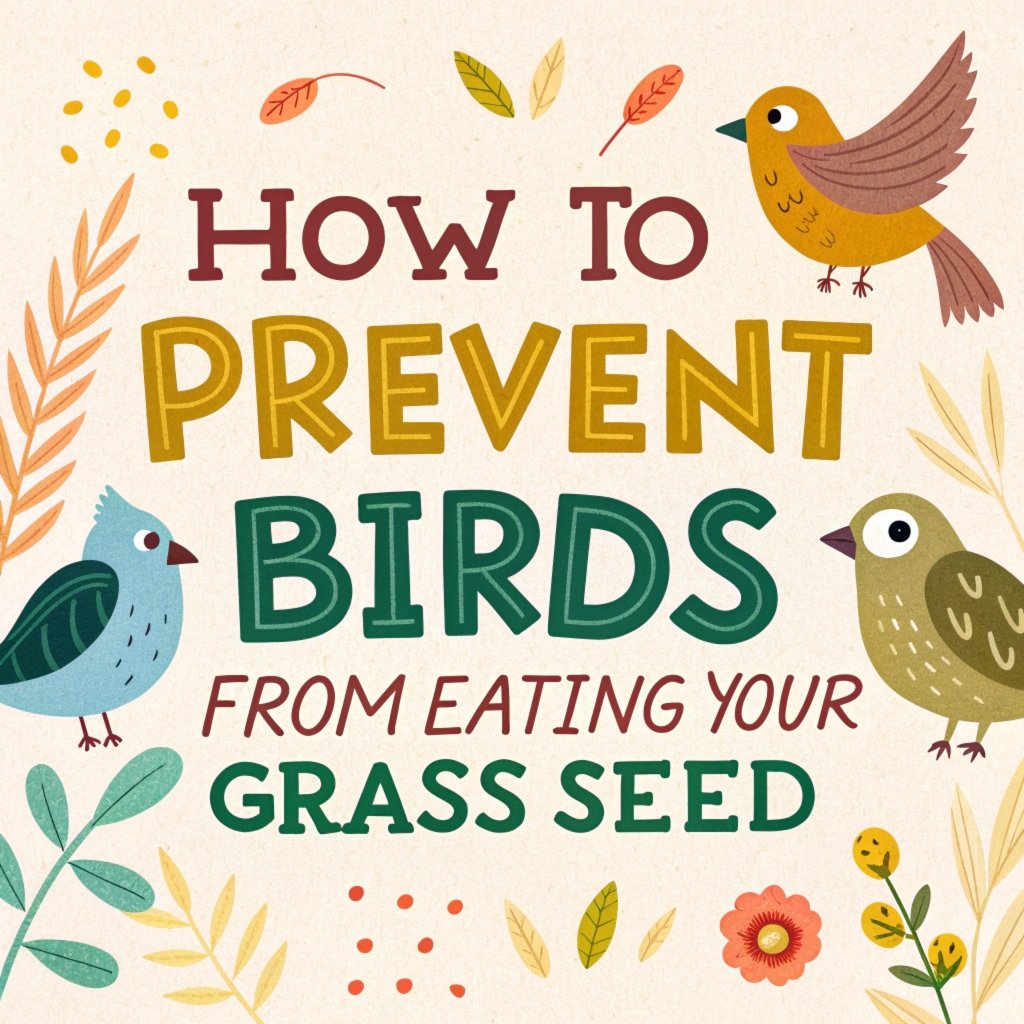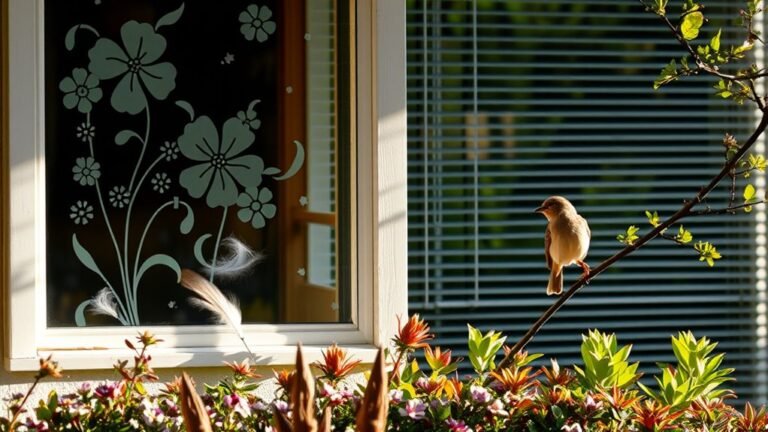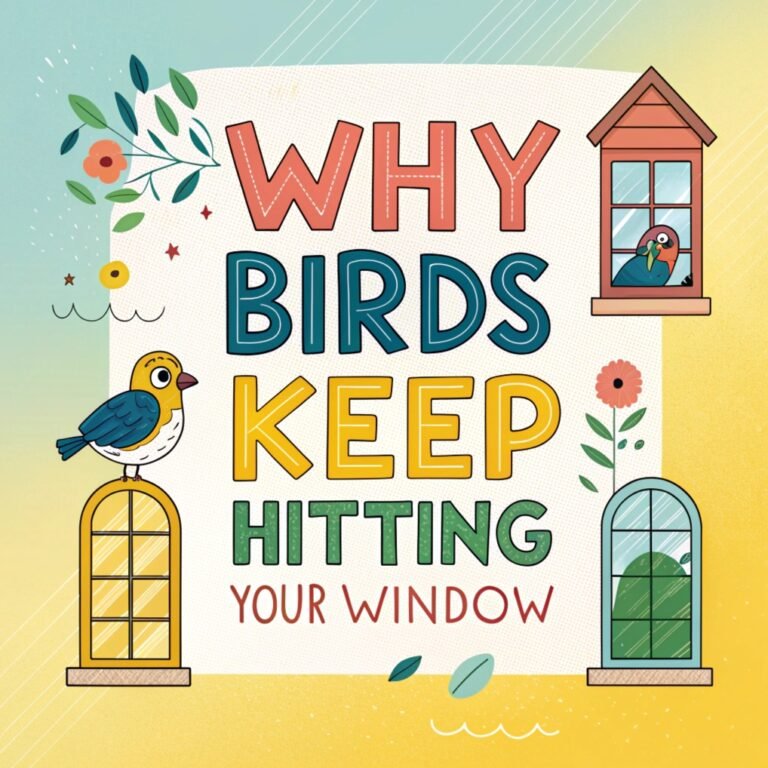How to Prevent Birds from Eating Your Grass Seed: Amazing Green Lawn
Birds can be a significant challenge when trying to establish a new lawn or overseed an existing one.
These feathered friends often view freshly sown grass seed as a delicious buffet, potentially ruining your efforts to create a beautiful, green space.
However, with the right strategies and techniques, you can protect your grass seed from hungry birds and ensure successful germination.

Key Takeaways:
Here are the key points to remember when protecting your grass seed from birds:
- Utilize wind chimes or electronic bird repellent devices that produce distress signals.
- Vary sounds and timing to prevent birds from becoming habituated.
- Consider the impact on neighbors when using noise-making devices.
- Seed outside peak bird activity times (early morning and late afternoon).
- Choose the right season for seeding, such as fall when bird populations may be lower.
- Seed in the evening to give seeds a head start before birds become active.
- Use grass seed products with built-in bird repellents that are non-toxic.
- Combine these products with other protective measures for maximum effectiveness.
- Set up bird feeders or designated feeding areas away from your seeded lawn.
- Offer alternative seeds that birds prefer over grass seed.
- Maintain these feeding areas regularly to keep birds interested.
- Apply liquid bird repellents that contain ingredients birds find unpleasant.
- Follow manufacturer instructions for application and reapplication.
- Choose biodegradable and safe products for use around plants and animals.
- Regularly monitor your seeded area for signs of bird activity or damage.
- Be prepared to adjust your strategy if one method is not effective.
- Combine multiple deterrent methods for better results.
By following these key takeaways, you can effectively protect your grass seed from birds and ensure a healthy, lush lawn.
Understanding Why Birds Are Attracted to Grass Seed
Birds are naturally drawn to grass seed as it provides an easy and nutritious food source. Species like sparrows, finches, blackbirds, and starlings are particularly fond of these seeds.
When you sow grass seed, you’re essentially creating an open invitation for birds to feast. Understanding this behavior is crucial in developing effective strategies to protect your lawn.
The attraction is not just about the food itself but also the visibility and accessibility of the seeds. Newly sown lawns often have exposed soil, making it easy for birds to spot and access the seeds.
Additionally, the timing of seeding can coincide with periods when birds are actively foraging for food, especially during breeding seasons or migration.
The Importance of Protecting Your Grass Seed Investment
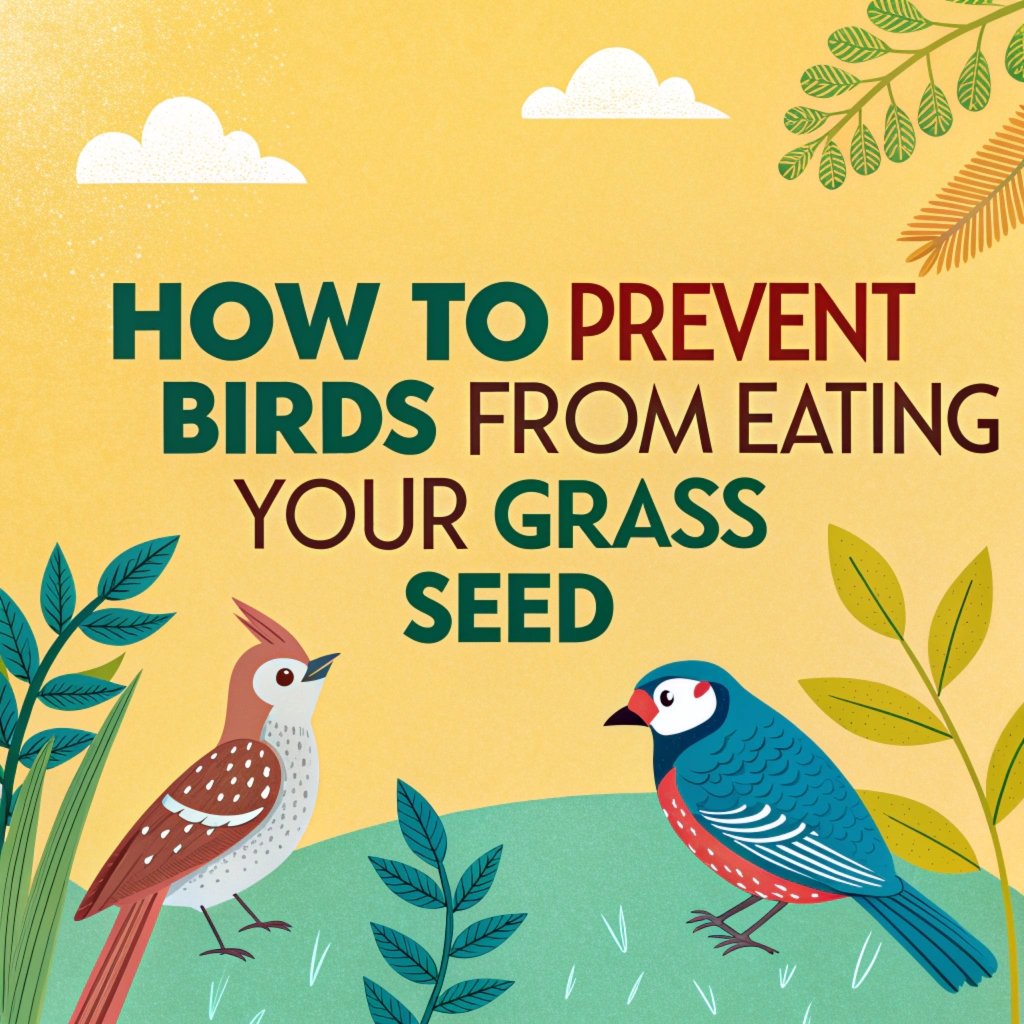
Protecting your grass seed is vital for several reasons. Firstly, grass seed can be expensive, especially if you’re covering a large area or using high-quality varieties. Losing a significant portion of your seed to birds can be a costly setback.
Secondly, unprotected seeds may result in uneven growth, leading to patchy lawns that require additional work and resources to fix.
Moreover, consistent bird feeding can disrupt the germination process, preventing seeds from establishing strong roots. This can lead to weak grass plants that are more susceptible to disease and environmental stresses.
By implementing effective bird deterrent strategies, you’re not just saving seeds but also ensuring the long-term health and appearance of your lawn.
Physical Barriers: Netting and Mesh Solutions
One of the most effective methods to prevent birds from eating grass seed is using physical barriers like netting or mesh.
These solutions create a protective layer over your seeded area, allowing water and sunlight to penetrate while keeping birds out.
Lightweight netting or bird-proof mesh can be stretched over the seeded area and secured at the edges.
When installing netting, ensure it’s raised slightly above the soil surface to allow for seed germination and grass growth.
Use stakes or hoops to elevate the netting, creating a tent-like structure over your lawn. This method is particularly effective for larger areas and can be easily removed once the grass has established itself.
Remember to check the netting regularly to ensure no birds have become entangled. Choose a mesh size that’s small enough to prevent birds from accessing the seeds but large enough to allow proper air circulation and water penetration.
Mulching Techniques to Hide Grass Seed
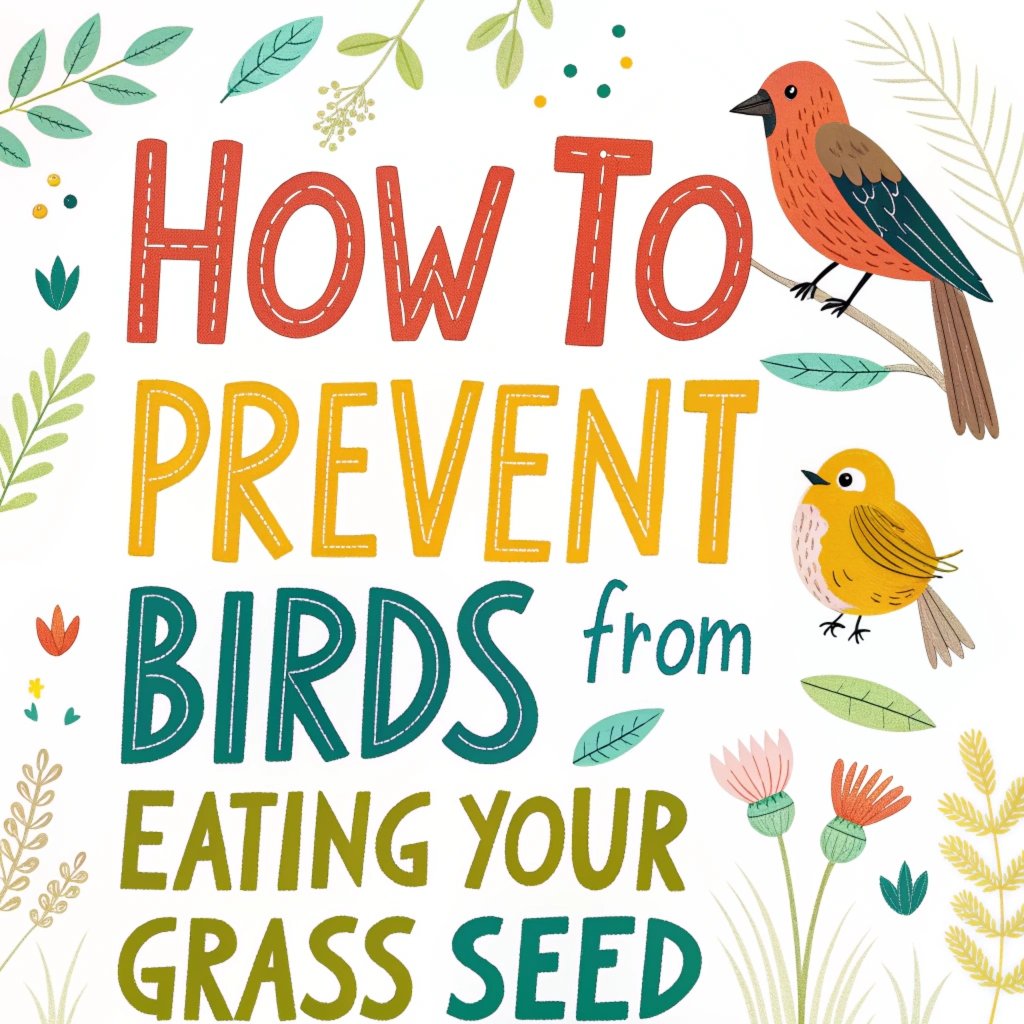
Mulching is another excellent strategy to protect your grass seed from birds. By covering the seeds with a thin layer of straw, compost, or topsoil, you can effectively hide them from view while still allowing for proper germination.
This method not only deters birds but also offers additional benefits for seed growth.
When applying mulch, aim for a light covering that allows some light to penetrate. A layer about 1/4 inch thick is usually sufficient.
Straw mulch is particularly effective as it’s lightweight and easy to spread. Ensure you use weed-free straw to prevent introducing unwanted plants to your lawn.
Mulching also helps retain soil moisture, regulate soil temperature, and prevent seed erosion. As the grass grows, the mulch will naturally decompose, providing additional nutrients to the soil.
This method is especially useful in areas prone to heavy bird activity or for those looking for a more natural approach to seed protection.
Visual Deterrents: Reflective Objects and Decoys
Visual deterrents can be highly effective in scaring birds away from your newly seeded lawn. These methods work by creating an environment that appears unsafe or unappealing to birds.
Reflective objects like old CDs, aluminum pie plates, or specially designed reflective tape can be hung around the seeded area.
The movement and light reflection from these objects can disorient and frighten birds, discouraging them from landing.
Similarly, decoy predators such as plastic owls or hawks can be placed strategically around your lawn. Birds instinctively avoid areas where they perceive predators to be present.
For maximum effectiveness, move these visual deterrents periodically to prevent birds from becoming accustomed to their presence.
Combining different types of visual deterrents can create a more dynamic and unpredictable environment for birds, enhancing their effectiveness in protecting your grass seed.
Sound-Based Bird Repellents
Sound-based repellents offer another layer of protection for your grass seed. These devices emit sounds that birds find distressing or threatening, encouraging them to stay away from the area.
Options range from simple wind chimes to more sophisticated electronic bird repellent devices that produce predator calls or distress signals.
When using sound-based repellents, it’s important to vary the sounds and timing to prevent birds from becoming habituated.
Some electronic devices offer randomized patterns of sounds, which can be more effective long-term.
Consider the impact on your neighbors when using these devices, especially if they produce loud or frequent noises.
For a more natural approach, you can also use recordings of predator birds like hawks or owls. Playing these sounds occasionally, especially during peak bird activity times in the early morning or late afternoon, can be an effective deterrent.
Timing Your Seeding to Minimize Bird Activity
Strategic timing of your grass seeding can significantly reduce bird interference. Birds are typically most active in feeding during the early morning and late afternoon.
By seeding your lawn outside these peak times, you can give your grass a head start before birds become aware of the new food source.
Consider seeding in the evening, which allows the seeds to settle overnight before birds become active. Additionally, choosing the right season for seeding can make a difference.
In many regions, fall is an ideal time for seeding as bird populations may be lower due to migration patterns.
Timing your seeding to coincide with periods of natural food abundance for birds can also help. When birds have plenty of other food sources available, they may be less likely to target your grass seed.
Using Bird-Repellent Grass Seed Products
Many grass seed products now come with built-in bird repellents. These seeds are coated with substances that birds find unpalatable, discouraging them from feeding on the seeds.
While not 100% effective, these products can significantly reduce bird damage to your newly seeded lawn.
When choosing bird-repellent grass seed, look for products that use non-toxic repellents to ensure safety for birds and other wildlife.
Some coatings also offer additional benefits like improved water retention or fungal resistance, which can enhance seed germination and early growth.
It’s important to note that while these products deter birds, they don’t eliminate the need for other protective measures, especially in areas with high bird populations or persistent bird problems.
Creating Alternative Feeding Areas
One effective strategy to protect your grass seed is to provide birds with an alternative food source.
By setting up bird feeders or creating designated feeding areas away from your newly seeded lawn, you can divert birds’ attention and satisfy their hunger elsewhere.
Place these feeding stations at a distance from your seeded area, preferably in a spot that’s more attractive to birds, such as near trees or shrubs.
Offer a variety of seeds that birds prefer over grass seed, such as sunflower seeds, millet, or nyjer seeds.
This method not only protects your grass seed but also allows you to enjoy the presence of birds in your garden without them causing damage to your lawn.
Remember to maintain these feeding areas regularly to keep birds interested and away from your grass seed.
Liquid Bird Repellents and Sprays
Liquid bird repellents and sprays can be an effective way to deter birds from eating your grass seed.
These products typically contain ingredients that birds find unpleasant in taste or smell. When applied to the seeded area, they create a barrier that discourages birds from feeding.
Many of these repellents are biodegradable and safe for use around plants and animals. They often need to be reapplied after rain or heavy watering.
When using liquid repellents, follow the manufacturer’s instructions carefully to ensure effective application and to avoid any potential harm to your grass or the environment.
Some gardeners have success with homemade repellents using ingredients like cayenne pepper or garlic, but commercial products are often more reliable and longer-lasting.
Remember that while these sprays can be effective, they work best when combined with other deterrent methods.
Maintaining Vigilance and Adapting Your Strategy
Protecting your grass seed from birds requires ongoing attention and adaptability. What works in one situation may not be as effective in another, so be prepared to adjust your approach. Regularly monitor your seeded area for signs of bird activity or damage.
If you notice birds overcoming one deterrent method, be ready to implement another or combine multiple strategies.
For instance, if visual deterrents alone aren’t sufficient, consider adding sound-based repellents or physical barriers.
Remember that persistence is key. Birds can be resourceful, so maintaining your protective measures until the grass is well-established is crucial. Once the grass has grown to a mowable height, the risk of bird damage significantly decreases.
FAQs
How long do I need to protect my grass seed from birds?
Typically, you should protect your grass seed for about 2-3 weeks after sowing. This period allows the seeds to germinate and establish roots. Once the grass blades are about an inch tall, birds are less likely to disturb them.
Are bird repellents harmful to other wildlife or pets?
Most commercial bird repellents are designed to be safe for other animals. However, always read the product labels carefully and choose repellents that are non-toxic and environmentally friendly. If you have pets, it’s best to keep them away from treated areas until the product has dried or settled.
Can I use pesticides to keep birds away from my grass seed?
It’s not recommended to use pesticides to deter birds. Many pesticides are harmful to birds and other wildlife. Instead, focus on bird-specific repellents and physical barriers that are safe and effective.
What’s the best time of year to plant grass seed to avoid bird damage?
Fall is often the best time to plant grass seed, as many bird species have migrated, reducing the likelihood of seed predation. Spring can also be effective, but be prepared for more bird activity.
How effective are fake predators like plastic owls in protecting grass seed?
Fake predators can be effective initially, but birds may become accustomed to them if they remain stationary. For best results, move these decoys regularly and combine them with other deterrent methods.
Will covering my grass seed with straw prevent it from growing?
A light layer of straw can actually benefit grass seed by retaining moisture and providing some protection. However, avoid applying it too thickly. A thin layer that still allows light to penetrate is ideal.
Can I use netting on a sloped lawn?
Yes, netting can be used on sloped lawns. Ensure it’s securely anchored at the top and bottom of the slope to prevent sagging or shifting that might allow birds access to the seeds.
How often should I reapply liquid bird repellents?
Most liquid repellents need to be reapplied every few days or after rain. Check the product instructions for specific guidance, as effectiveness can vary between products.
Will bird deterrents affect the germination of my grass seed?
When used correctly, bird deterrents should not negatively impact seed germination. In fact, by protecting the seeds from disturbance, they often improve germination rates.
Is it legal to use bird deterrents in my area?
Most bird deterrent methods are legal, but it’s always wise to check local regulations, especially regarding noise-making devices or certain types of netting. Some areas may have restrictions on methods that could potentially harm or trap birds.

Hello, I’m Amelia White, the founder of birdsfanatic.com. As a lifelong bird enthusiast and spiritual seeker, I’ve always been fascinated by the mystical connections between birds and the human experience. On this site, I share my knowledge and insights into the symbolic meanings and spiritual significance of various bird species, exploring their roles in mythology, folklore, and cultural traditions. Join me on this journey into the world of birds, where we’ll discover the hidden wisdom and guidance that these magnificent creatures have to offer.

